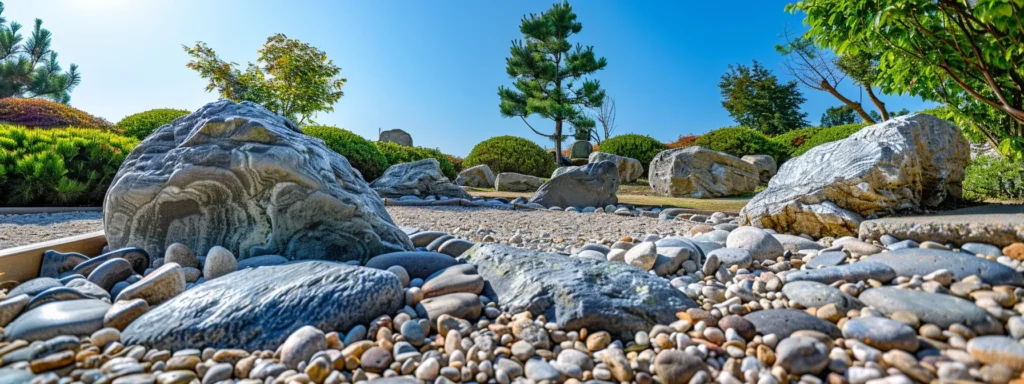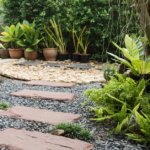
Best Landscape Rock Options for Effective Drainage
Are your landscaping efforts hindered by poor drainage? If so, choosing the right landscape rock is crucial for effective water management. In this article, you will learn about essential gravel types, the best rocks for drainage, and installation techniques that ensure your landscape stays dry. By understanding these key concepts, you can prevent water accumulation and create a more functional outdoor space. Let’s address your drainage issues together and enhance your landscape‘s overall efficiency.
The Essentials of Gravel for Drainage
Gravel serves as an excellent material for achieving effective drainage in your landscape design. By allowing water to flow freely, it minimizes standing water and helps avoid erosion issues that can arise from heavy rainfall. Selecting the right size and type of gravel ensures optimal performance in your drainage system.
Incorporating gravel around your planting areas can aid in controlling weed growth, providing a more aesthetically pleasing environment. Utilizing gravel as a mulch alternative not only enhances visual appeal but also assists in weed suppression, preventing the need for harsh herbicides that could damage your plant life.
When installed properly, gravel can act as an erosion control measure, directing water away from vulnerable areas. This helps maintain the integrity of slopes and flat surfaces, ensuring that soil remains intact while promoting the health of your garden or landscape. Understanding proper placement and layering techniques is key to maximizing its benefits.
Choosing the right gravel type and creating a proper drainage system makes a difference in your landscape‘s longevity. By weavinggravel into your design, you enhance both functionality and beauty, ultimately leading to effective drainage solutions. Investing in quality gravel pays off through minimized erosion and reduced maintenance requirements.
Gravel is essential for good drainage, but not all rocks are created equal. Explore the best options to ensure your drainage system works effectively and lasts.
The Best Rock to Use for Effective Drainage
When considering landscape rocks for effective drainage, crushed stone is a popular choice. Its angular shape promotes excellent soilfiltration, allowing water to flow freely while reducing the risk of puddles around your driveway or planting areas.
Another effective option is gravel, which not only aids in drainage but also supports weed control. By laying down a layer of gravel, you can suppress weed growth, reducing the need for chemical herbicides that can harm your soil and surrounding plants.
River rock is also beneficial for drainage systems, especially in areas that receive heavy rainfall. Its smooth surface facilitates water movement while adding a decorative touch to your landscape, making it suitable for pathways or decorative beds.
Finally, volcanic rock serves as an excellent drainage solution with added benefits. This lightweight material allows for proper water flow and supports soil health by creating air pockets, which can further enhance drainage efficiency in your landscape design.
Choosing the right rock is just the beginning. Discover which landscape rocks meet your specific drainage needs next, and how they can make all the difference.
Best Landscape Rock Options for Specific Drainage Needs
Peagravel is an excellent choice for areas requiring high permeability. Its rounded shape allows water to flow freely, making it suitable for driveways and planting beds where drainage is essential.
Granitegravel provides not only durability but also promotes effective water movement. Its angular edges help with soil stability while encouraging efficient drainage, making it ideal for erosion-prone areas.
Incorporating a layer of geotextile fabric beneath your chosen rock can further enhance drainage solutions. This fabric allows water to pass through while preventing soil from mixing with the gravel, ensuring long-lasting effectiveness.
For situations involving seed placement, choosing the right landscape rock is crucial. Utilizing a combination of fine gravel with larger stones offers both support for newly planted seeds and facilitates proper drainage, creating a healthier growing environment.
The right stones matter, but how you place them counts even more. With proper techniques, you can ensure that your landscape not only looks good but drains effectively.
Installation Techniques for Optimal Drainage Solutions
Begin your installation by creating a trench for the drainage system. This trench will guide excess water away from your landscape, preventing water damage to your plants and structures. Ensure that the trench slopes slightly away from any foundations to encourage proper water flow.
Choose the right gravel for your trench, as this will play a vital role in effective drainage. Opt for angular gravel which allows for better water filtration and prevents clogging. This will enhance the overall drainage of your landscape, ensuring that water moves efficiently.
Consider layering geotextile fabric at the bottom of the trench before adding gravel. This fabric allows water to pass through while blocking soil from mixing with the gravel, maintaining the integrity of your drainage solution. This technique is particularly useful in xeriscaping projects where maintaining soil moisture is critical.
After installing gravel, compact it to ensure stability and prevent shifting. Regularly inspect your drainage system to ensure it remains effective, especially after heavy rains. Following these installation techniques protects your landscape and minimizes the risk of water damage over time.
Your work on drainage solutions is only the beginning. Now, let’s turn to how you keep your drainagelandscape rock looking its best.
Maintaining Your Drainage Landscape Rock
Regular maintenance of your drainagelandscape rock is essential to ensure its effectiveness over time. Remove any debris or organic material that may accumulate on the surface, as this can hinder water flow and create unwanted conditions for pests.
Inspect the area for any shifts in the gravel or pebble layers that may occur after heavy rainfall. If you notice any displacements, redistribute the rock and ensure that the underlying sand and woven fabric remain intact to maintain effective drainage.
Periodically check the condition of the topsoil around your landscape rocks. If the topsoil becomes compacted, consider lightly aerating it to promote better water absorption, allowing your drainage system to work optimally through the best landscape rock for drainage.
Over time, it may be necessary to replenish the layer of gravel or pebbles, especially in areas where wear is evident. By refreshing the surface, you can sustain effective water movement and preserve the aesthetic appeal of your landscape design.
Caring for your drainagelandscape rock is just the start. Next, you must weigh the cost of your choices, as each rock tells a story of value and design.
Cost Considerations for Landscape Rock Selection
When planning your landscape rock selection, consider the overall budget for your project. The cost varies significantly depending on the type of rock you choose, from affordable gravel to more expensive boulders. Ensure you account for transportation costs, especially if you need a cart to move heavy materials to your site.
Additionally, implementing landscape fabric can raise initial expenses but offers long-term benefits. This material helps prevent soil from mixing with your landscape rocks, maintaining effective drainage. Investing in quality fabric can save you money over time by minimizing maintenance and reducing the risk of flood issues.
If you are considering a French drain installation, the rock choice will impact both function and cost. Using the correct type of rock ensures proper filtration and drainage efficiency. Choosing high-quality gravel or crushed stone for your French drain may be more costly upfront, but it prevents unnecessary repairs related to poor water management.
Finally, always factor in maintenance costs associated with your landscape rock selection. You may need to replenish certain materials over time, especially in high-traffic areas or where erosion occurs. Long-lasting options, though potentially pricier, often reduce replacement expenses and enhance the overall stability of your drainage system.
Final Thoughts on Choosing Landscape Rock for Effective Drainage
Selecting the best landscape rock options is vital for achieving effective drainage in your outdoor spaces. Rocks like peagravel, granitegravel, and river rock enhance water movement while minimizing erosion and weed growth. Implementing these materials not only improves the functionality of your drainage system but also boosts the aesthetic appeal of your landscape. Make informed choices about your landscape rocks to ensure long-lasting benefits for both your garden’s health and visual appeal.


